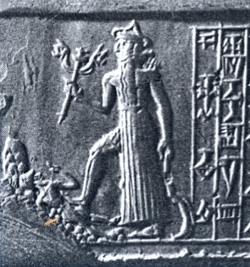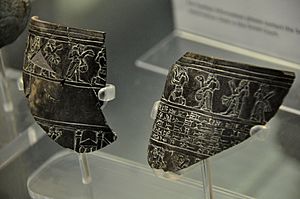Nergal facts for kids
Quick facts for kids Nergal |
|
|---|---|
| God of war, disease, and death | |

Nergal holding his attributes—a lion-headed mace and a sword—on a cylinder seal from Larsa
|
|
| Major cult center | Kutha |
| Abode | Kur (the Mesopotamian underworld) |
| Planet | Mars |
| Symbol | lion-headed mace, sword, lion, bull, possibly chameleon |
| Number | 14 |
| Personal information | |
| Consort | |
| Children | Tadmushtum |
| Parents | Enlil and Ninlil |
| Siblings | Nanna, Ninazu, Enbilulu (in the myth Enlil and Ninlil) |
| Equivalents | |
| Southern Mesopotamian equivalent | Ninazu |
| Akkadian equivalent | Erra |
Nergal (Sumerian: 𒀭𒄊𒀕𒃲 dKIŠ.UNU or dGÌR.UNU.GAL; Hebrew: נֵרְגַל, Modern: Nergal, Tiberian: Nērgal; Aramaic: ܢܸܪܓܲܠ; Latin: Nirgal) was a Mesopotamian god. He was primarily associated with war, death, and disease, and has been described as the "god of inflicted death".
His primary cult center was Kutha, located in the north of historical Babylonia. His main temple bore the ceremonial name E-Meslam and he was also known by the name Meslamtaea, "he who comes out of Meslam". Initially he was only worshiped in the north, with a notable exception being Girsu during the reign of Gudea of Lagash, but starting with the Ur III period he became a major deity in the south too. He remained prominent in both Babylonia and Assyria in later periods, and in the Neo-Babylonian state pantheon he was regarded as the third most important god, after Marduk and Nabu.
Contents
Character
Nergal was the god of the underworld. He was believed to decide fates of the dead the same way as Enlil did for the living.
In addition to being a god of the underworld, Nergal was also a war god, believed to accompany rulers on campaigns, but also to guarantee peace due to his fearsome nature serving as a deterrent. He was also associated with disease and played an important role in rituals.
Nergal was associated with Mars. Like him, this planet was linked with disease (especially kidney disease) in Mesopotamian beliefs.
Parents and siblings
Enlil and Ninlil are mentioned as Nergal's parents in the overwhelming majority of sources.
In the myth Enlil and Ninlil Nergal's brothers are Ninazu (usually instead a brother of Ninmada), Nanna and Enbilulu.
Wives and children
Multiple goddesses are attested as Nergal's wife in various time periods.
Laṣ was the goddess most commonly regarded as Nergal's spouse. Another goddess often viewed as the wife of Nergal was Mammitum. In the Nippur god list Laṣ occurs separately from Nergal, while Mammitum is present right behind him. The Middle Babylonian god list An = Anum mentions both Laṣ and Mamitum, equating them with each other, and additionally calls the goddess Admu ("earth") Nergal's wife.
In third millennium BCE in Girsu, the spouse of Nergal (Meslamtaea) was Inanna's sukkal Ninshubur.
According to the myth Nergal and Ereshkigal he was married to Ereshkigal, the goddess of the dead. In god lists, however, they do not appear as husband and wife.
Nergal's daughter was Tadmushtum, a minor underworld goddess. In an offering list she appears alongside Laṣ.
Worship

Nergal's main cult center was Kutha, where his temple E-Meslam was located.
In the Old Babylonian period Nergal continued to be worshiped as a god of the dead. He appears for the first time in documents from Uruk in this period. Nergal continued to be worshiped in Uruk as late as in early Achaemenid times, and he is mentioned in a source from the 29th year of the reign of Darius I.
Ancient lists of temples indicate that a temple of Nergal bearing the name E-šahulla, "house of the happy heart", was located in Mê-Turan. It was identified during excavations based on brick inscriptions and votive offerings dedicated to Nergal. In Lagaba, Nergal was worshiped under the name Išar-kidiššu.
In the Neo-Babylonian period Nergal was regarded as the third most important god in the Babylonian state pantheon after Marduk and Nabu. These three gods often appear together in royal inscriptions. In some families it was seemingly customary to give the third son a theophoric name invoking Nergal, in accordance with his position in the state pantheon.
Mythology
Nergal and Ereshkigal
Two versions of the myth Nergal and Ereshkigal are known.
After Nergal fails to pay respect to Ereshkigal's sukkal Namtar during a feast, she demands to have him sent to the underworld to answer for it.
Nergal descends to the underworld, but he's able to avoid many of its dangers thanks to advice given to him by Ea. However, he ignores one of them, and becomes romantically involved with Ereshkigal. After six days he decides to leave while Ereshkigal is asleep. After noticing this she dispatches Namtar, and demands the other gods to convince Nergal to return again, threatening to open the gates of the underworld if she does not get what she asks for. Nergal is handed over to her again.
In the Amarna version, where Ereshkigal initially planned to kill Nergal, he defeats Namtar and prepares to kill Ereshkigal. To save herself, she suggests that they can get married and share the underworld.
Epic of Erra
The oldest surviving copies of the Epic of Erra come from the Assyrian city of Nineveh and have been dated to the seventh century BCE, but it has been argued that the composition is between 100 and 400 years older than that based on possible allusions to historical events which occurred during a period of calamity which Babylonia experienced roughly between eleventh and eighth centuries BCE.
Nergal desires to wage war to counter a state of inertia he found himself in. His weapons (the Sebitti) urge him to take action, while his sukkal Ishum attempts to stop him. Nergal dismisses the latter, noting that it is necessary to regain respect in the eyes of humans, and embarks on a campaign.
His first goal is Babylon. Through trickery he manages to convince Marduk (portrayed as a ruler past his prime, rather than as a dynamic hero, in contrast with other compositions) to leave his temple. However, Marduk returns too soon for Nergal to successfully start his campaign, and as a result in a long speech he promises to give other gods a reason to remember him. As a result of his declaration (or perhaps because of Marduk's temporary absence), the world seemingly finds itself in a state of cosmic chaos.
Ishum once again attempts to convince Nergal to stop, but his pleading does not accomplish its goal. Nergal's acts keep escalating and soon Marduk is forced to leave his dwelling again, fully leaving the world at Nergal's mercy. A number of graphic descriptions of the horrors of war focused on nameless humans suffering because of Nergal's reign of terror follow. This is still not enough, and he declares his next goal is to destroy the remaining voices of moderation, and the cosmic order as a whole.
However, Ishum eventually manages to bring an end to the bloodshed. He does so by waging a war himself. Ishum's war is described in very different terms to Nergal's, and with its end the period of instability comes to a close.
Interesting facts about Nergal
- Nergal was the third most important god in the Babylonian state pantheon after Marduk and Nabu.
- His name can be translated from Sumerian as "lord of the big city" (meaning the underworld).
- Nergal's attributes were mace, dagger and bow.
- He was often depicted in a type of flat cap commonly worn by underworld deities in Mesopotamian glyptic art.
- Bulls and lions were associated with Nergal.
- Nergal was often invoked to protect houses from evil.
Related pages
See also
 In Spanish: Nergal para niños
In Spanish: Nergal para niños



